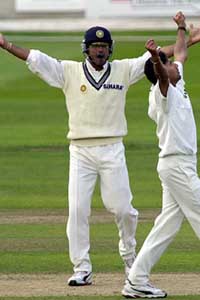A moral victory for the Indians
© CricInfo Given India's abysmal record abroad, especially in England, a shared Test series can be rated as a moral victory and congratulations would seem to be in order for Sourav Ganguly and his men, more so when the balance sheet includes the
Partab Ramchand
11-Sep-2002
 © CricInfo |
It looks like the bowling will continue to be a major headache
for future selectors and team managements. There were no
indications on this tour whatsoever that there would be an early
end to this problem.
The England batsmen, generally known for their dour approach,
made hay while the sun shone. In three of the four Tests, the
hosts rattled up totals of 487, 301 for six declared, 617 and 515
in quick time against bowling that lacked both ideas and
penetration. At the end of the four-Test series, three English
batsmen had averages exceeding 100, two had averages in the
fifties and three more had averages in the forties. As many as
six centuries - two of them near double hundreds - and 12 halfcenturies made for a pretty high proportion of high scores.
These figures put the unimaginative bowling in proper
perspective. To be sure, the bowling was not expected to work
wonders and it is to their credit that they shared the glory with
the batsmen in shaping the victory at Headingley. But then
consistency is one quality that has been lacking in Indian
bowling of late and this was proved again in England.
Anil Kumble again failed to deliver though his figures of 14
wickets at 36 apiece were an improvement over his recent figures
abroad. Harbhajan Singh took credit for notching up the only
five-wicket haul in the series for both sides but his figures of
12 wickets at an average of 34.16 clearly do not establish him as
a match-winner outside India.
Zaheer Khan was one bowler who emerged with full credit though
his figures of 11 wickets at 43.90 apiece fail to do him justice.
He troubled the batsmen time and again with deceptive change of
pace and disconcerting bounce and movement. There is little doubt
that among the lot of young pace bowling hopefuls who emerged
over the past couple of years, the left-armer has clearly won the
race to be the spearhead and the logical and worthy successor to
Javagal Srinath.
Ashish Nehra, it must be said, did not exactly grab the
opportunity the tour presented him with both hands. He tended to
be wayward in line and length and not unexpectedly could not hold
his place in the side after the first two Tests.
Ajit Agarkar continued to be a puzzle. The lad possesses pace of
the whippy kind and now and then had the batsmen on the hop with
deliveries that rose sharply. But he was just as capable of
sending the perfect half-volley or long hops that even a No 11
batsman can heartily thump to the boundary. He could perhaps do
with another visit to the MRF Pace Academy in Chennai for a few
tips from pace guru Dennis Lillee.
As far as the bowling was concerned, there were two surprises.
One was that Sourav Ganguly bowled only 12 overs in the four
Tests. It must not be forgotten that he headed the bowling
figures for the Tests in 1996 and given this background, his
reluctance to bowl himself was baffling.
The second was the tidy work done by Sanjay Bangar. The
conditions might have suited his dibbly-dobbly style of bowling
but full marks to the rather inexperienced bowler who maintained
a steady line and length to head the bowling averages with four
wickets at 29.25 apiece.
But if there were problems aplenty in the bowling department, the
batting looked as healthy as ever except at the top of the order
where only one half-century partnership was registered in six
innings. Indian batting, particularly in the last few years, has
been a sight for the gods. But even by these lofty standards, the
batsmen exceeded expectations. Sure, they had one bad day at the
office at Lord's but after that there was no stopping them.
The England bowlers felt the heat as in successive innings, the
Indians ran up totals of 397, 357, 424 for eight, 628 for eight
declared and 508 with batting of the royal class. The most
heartening aspect was that the big three came off in spades.
Never before have Rahul Dravid, Sachin Tendulkar and Sourav
Ganguly performed in unison as they did in this series.
 © CricInfo |
Tendulkar had to take second billing but he lived up to his
reputation with a near double hundred and two other scores over
the half century towards a tally of 401 runs at an average of
66.83. Ganguly was a picture of consistency with 351 runs at an
average of 58.50 with a century and three fifties.
To complete the happy picture, the big three received more than
adequate support from Virender Sehwag, VVS Laxman and Agarkar
even if the blustering approach of Sehwag meant that he was
liable to be caught at slip early in his innings. And Bangar's
batting, built on first principles, came as a bonus. Indeed, the
strength of the batting can be gauged by the fact that Shiv
Sundar Das, in spite of getting 250 against Essex, could not
force his way back into the side.
Both the wicket-keepers Ajay Ratra and Parthiv Patel performed
commendably and as far as this department is concerned, it looks
like the selectors will not have a problem for a long time.

